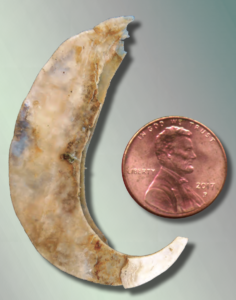Pacific Migration, Existence, and Paradox: A Deep History
This fish hook represents an epistemological need for historians and archaeologists alike to seek out, consider, and incorporate “submerged” objects as important to a new archaeological (and perhaps indigenous) understanding of the Pacific.

Can the "Submerged" Speak?
Museo Histórico Regional in Ensenada of the
Instituto
Nacional de Antropología y Historia
Baja California, Mexico
Photo courtesy of Matthew des Lauriers
The Cedros Island fish hook adds towards increasing evidence for the “once-heretical” view that the peopling of the Americas was accomplished by coastal voyage. But of course, it must also be acknowledged that the fish hook discoveries on Cedros Island are not conclusive evidence of these coastal migration theories by far, even if they do heavily indicate boat use in that geographical area; after all, the researchers involved in that project acknowledge that it is still possible that the first Americans who eventually settled the area might have first migrated via an ice-free corridor before later on adapting to a maritime life along the Baja California coast.
It is difficult to settle this question because the later glacial sea level rise at the end of the Pleistocene must have necessarily “drowned” many coasts and settlements of the time. Therefore, it is precisely because of this last point -- the existence of “drowned” objects” -- that one can re-interpret this fish hook as representative of an epistemological need for historians and archaeologists alike to seek out, consider, and incorporate what I have coined “submerged” objects as important to a new archaeological (and perhaps indigenous) understanding of the Pacific.
[Bonus Material: What's In A Fish Hook?]
In spite (or perhaps because) of their rarity, the discovery and catalog of fish hooks have always been critical to the study and placement of Pacific migration within a larger chronological context. For example, in the 1950s, scholars at the Bishop Museum in Hawai’i used various unearthed bone fishhooks in order to develop the first models predicting when the earliest humans arrived in the island archipelago; recently, those fish hooks have now been digitized and have made their way into increasingly novel inquiries about how island culture have changed “through time, and across Polynesia. For another related object within this exhibit, see the Lapita pot.
The “drowning” of so-called “submerged” objects is an epistemic and logistical problem related to the (lack of) preservation of underwater archaeological material, and the issue has only very recently begun to be considered more seriously as an issue to be solved by the archaeological discipline. In 2021, the Journal of Island and Coastal Archaeology devoted an issue to the so-called “submerged prehistory in the Americas,” whereupon one argument included the advancement of the question that “fundamental questions related to archaeology must now be studied efficiently underwater [to achieve] valuable academic results.” Another submission in that year’s edition looked towards the future with increased positivity, raising the possibility that the present-day United States may soon experience a renaissance in the historiography of its prehistory once various projects along promising coastal sites finish completion.
But the existence of submerged material not unlike the Cedros Island fish hook also necessarily raises serious normative ethical questions relating to ownership, displacement, and indigeneity once the objects (literally) re-emerge above ground/sealevel for analysis by scholars. Some of these questions are the same ones that exist for “non-submerged”, non-oceanic objects: for example, to whom submerged objects should be expatriated to lest we have another Kennewick Man situation on our hands (or whether they should be expatriated at all) is an obvious dilemma to resolve. But other questions seem to be more unique to the oceanic framework that submerged objects find themselves in. For example, can something be said about understanding and placing the notion of a submerged object within a hypothetical, so-called submerged society, especially in a world that has yet to truly grapple with Pacific subjugation and annexation? Does the fact that early peoples of the Americas are often wrongly depicted as primitive, without the capacity to develop seafaring on their own, have anything of relevance to say here as well? Or, what use can the concept of the “submerged” have in the present-day, whereupon Pacific Islanders and other often-indigenous peoples stand to hurt the most from expected rising sea levels brought upon by actors far larger than themselves?
[Bonus Material: What's Up With This Title?]
The curators of this exhibit suggest that so-called Pacific objects not unlike the Cedros Island fish hook must necessarily be understood as existing within a larger framework that they call the “submerged." This word coining is an intentional reference to the work of Antonio Gramsci, a twentieth-century culturalist coined the word “subaltern” in reference to the socioeconomic status of populations who are excluded from power within the structures of an often-colonial society; and to Gayatri Spivak, who wrote the famed postcolonial essay "Can the Subaltern Speak?" in 1988.
The implied parallels between the work of these old scholars and the new neologism thus seems fitting, given the recurring themes that emerge from studying the history of Pacific migration from the deep past up until the present day: migration, existence, and paradox.
The implied parallels between the work of these old scholars and the new neologism thus seems fitting, given the recurring themes that emerge from studying the history of Pacific migration from the deep past up until the present day: migration, existence, and paradox.